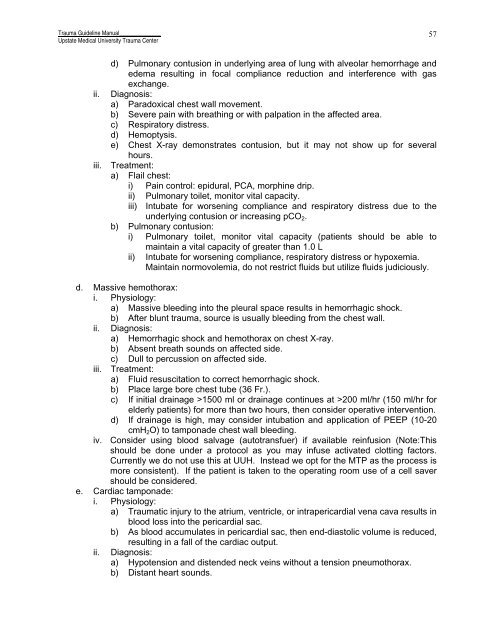Trauma Guideline Manual - SUNY Upstate Medical University
Trauma Guideline Manual - SUNY Upstate Medical University
Trauma Guideline Manual - SUNY Upstate Medical University
Create successful ePaper yourself
Turn your PDF publications into a flip-book with our unique Google optimized e-Paper software.
<strong>Trauma</strong> <strong>Guideline</strong> <strong>Manual</strong>______________<strong>Upstate</strong> <strong>Medical</strong> <strong>University</strong> <strong>Trauma</strong> Center57ii.d) Pulmonary contusion in underlying area of lung with alveolar hemorrhage andedema resulting in focal compliance reduction and interference with gasexchange.Diagnosis:a) Paradoxical chest wall movement.b) Severe pain with breathing or with palpation in the affected area.c) Respiratory distress.d) Hemoptysis.e) Chest X-ray demonstrates contusion, but it may not show up for severalhours.iii. Treatment:a) Flail chest:i) Pain control: epidural, PCA, morphine drip.ii) Pulmonary toilet, monitor vital capacity.iii) Intubate for worsening compliance and respiratory distress due to theunderlying contusion or increasing pCO 2 .b) Pulmonary contusion:i) Pulmonary toilet, monitor vital capacity (patients should be able tomaintain a vital capacity of greater than 1.0 Lii)Intubate for worsening compliance, respiratory distress or hypoxemia.Maintain normovolemia, do not restrict fluids but utilize fluids judiciously.d. Massive hemothorax:i. Physiology:a) Massive bleeding into the pleural space results in hemorrhagic shock.b) After blunt trauma, source is usually bleeding from the chest wall.ii.Diagnosis:a) Hemorrhagic shock and hemothorax on chest X-ray.b) Absent breath sounds on affected side.c) Dull to percussion on affected side.iii. Treatment:a) Fluid resuscitation to correct hemorrhagic shock.b) Place large bore chest tube (36 Fr.).c) If initial drainage >1500 ml or drainage continues at >200 ml/hr (150 ml/hr forelderly patients) for more than two hours, then consider operative intervention.d) If drainage is high, may consider intubation and application of PEEP (10-20cmH 2 O) to tamponade chest wall bleeding.iv. Consider using blood salvage (autotransfuer) if available reinfusion (Note:Thisshould be done under a protocol as you may infuse activated clotting factors.Currently we do not use this at UUH. Instead we opt for the MTP as the process ismore consistent). If the patient is taken to the operating room use of a cell savershould be considered.e. Cardiac tamponade:i. Physiology:a) <strong>Trauma</strong>tic injury to the atrium, ventricle, or intrapericardial vena cava results inblood loss into the pericardial sac.b) As blood accumulates in pericardial sac, then end-diastolic volume is reduced,resulting in a fall of the cardiac output.ii.Diagnosis:a) Hypotension and distended neck veins without a tension pneumothorax.b) Distant heart sounds.
















